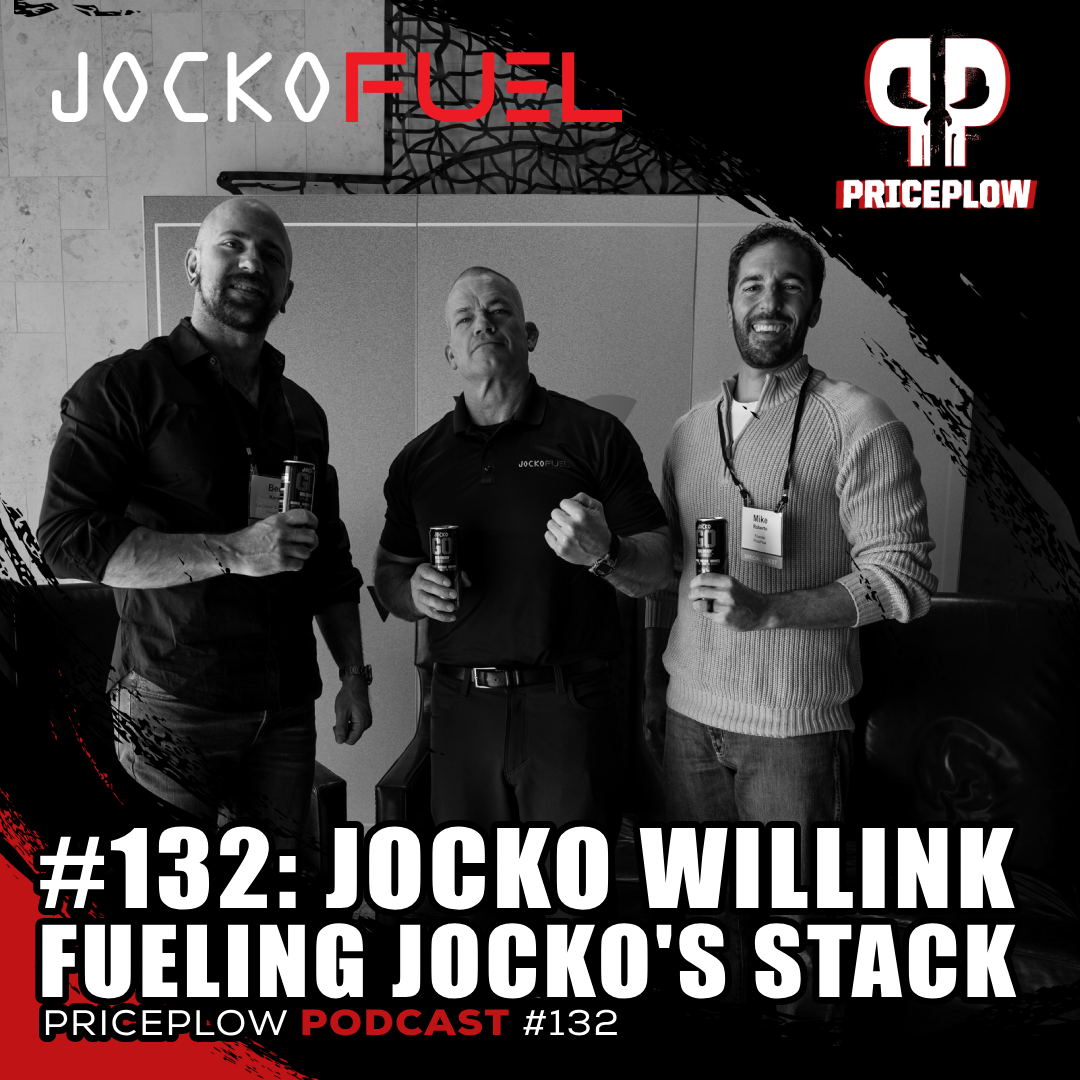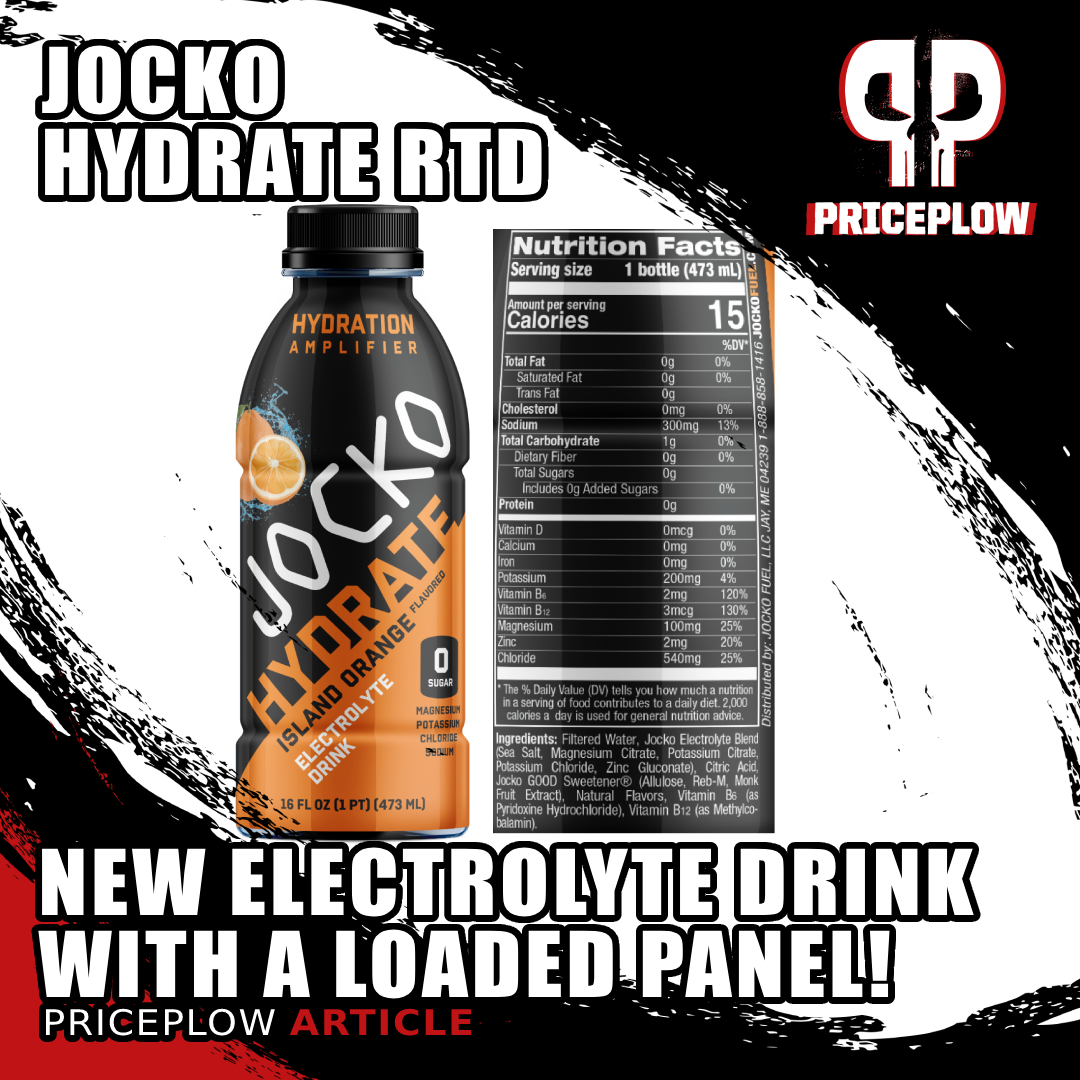
Fuel your gains and give back with Jocko Fuel's NEW Cookies & Cream Mölk Protein Powder! This powerhouse blend packs whey, casein, and egg white protein for sustained muscle recovery, while a portion of proceeds benefits the Travis Manion Foundation. Enjoy delicious creamy vanilla with real cookie pieces – conquer your workouts and support a hero's cause.
Jocko Willink is one of the biggest names in the world. As a former Navy Seal, Jocko has built an empire around himself – from books to corporate training, he is the go-to man for discipline and success.
The hard professionalism Jocko exemplifies carries over extremely well to his supplement brand, Jocko Fuel. After all, in order to get results when training, you need to be on point with diet, exercise, and supplements - and they have to be beyond Good. He explains this in Episode #132 of the PricePlow Podcast, where we talk about the creation of Jocko Fuel.
Jocko products always sit at the upper echelon of supplements, because the team has an eye for formulation, ingredient quality, and top-notch flavoring.
While the new Jocko Hydrate Drink RTD is the talk of the town because of its incredible naturally flavored and sweetened taste, all of these elements are also on display with the new Cookies and Cream flavor of the Jocko Mölk Protein Powder.
Mölk Protein Powder: Cookies and Cream Flavor is Out

Jocko Willink joins PricePlow for Episode 132 to talk about founding Jocko Fuel, doing the right thing when formulating supplements, and Jocko's entire stack from start to finish
There are thousands of protein powders on the market, and most of them are made with whey protein in some form. Whey protein has been shown to be the best, most bioavailable supplemental forms of protein, after all. That said, even protein powder can benefit from more diversity - especially in the sweetener department.
Mölk Protein Powder contains not just whey, but casein and egg white protein as well. With these additions, the powder has a longer-lasting, stabilized absorption curve, leading to a better recovery experience. And, like all other Jocko Fuel products, it's naturally sweetened.
We're going to dive into a little summary on how Jocko Mölk Protein Powder works, but first, let's check PricePlow for good Jocko deals, and check out our video review of the new flavor:
Jocko Fuel MOLK Protein Powder – Deals and Price Drop Alerts
Get Price Alerts
No spam, no scams.
Disclosure: PricePlow relies on pricing from stores with which we have a business relationship. We work hard to keep pricing current, but you may find a better offer.
Posts are sponsored in part by the retailers and/or brands listed on this page.
We've never covered Mölk before, so here's the full take on the nutrition facts and ingredients:
Jocko Mölk Protein Powder – Nutrition Facts
Each 37g scoop (of Cookies & Cream) contains the following nutrition profile:
-
Calories: 140
-
Total Fat: 3.5g
-
Total Carbohydrate: 7g
-
Dietary Fiber: 1g
-
Total Sugars: 2g
-
Added Sugars: 1g
-
-
-
Protein: 22g
High-Protein Diets are King
First, we're here because no matter what your diet is, high-protein should be your first focus if trying to improve your body composition, general health, and/or strength.[1-5] Protein is great for satiety,[6,7] has a better thermic effect than carbs and fats,[3,8] and can even support a healthier hormonal profile.[6]
You want protein, lots of it, and you want it from food. But the amount of protein needed to build quality amounts of muscle becomes a lot easier with protein shakes.[8-12] Let's talk about how Mölk stands alone against the competition:
Jocko Mölk Protein Powder Ingredients
The Jocko Protein Blend stands out due to its inclusion of a variety of animal-based protein sources.
-
Whey Protein Concentrate and Whey Protein Isolate
Jocko Fuel has revealed the Jocko Hydrate RTD drink, an absolutely delicious hydration beverage that stays true to Jocko's mantra of no artificial colors or sweeteners
Mölk's blend starts with whey protein concentrate, and whey protein isolate. Whey protein is known throughout the industry as the standard for supplementation due to its fast-acting,[13] high bioavailability[14] and status as a complete protein[15] with an incredibly high digestible indispensable amino acid score (DIAAS).[16]
This whey protein is derived from grass-fed cow's milk, and again, whey has been shown to help increase muscle mass and strength when paired with a solid diet and exercise regimen.[8,17-19]
Isolate: 90% Protein by Weight; Concentrate: 35-80% Protein by Weight
Whey protein's categorized into two main classes, depending on its protein yield. Whey protein concentrate (WPC) can have anywhere from 35-80% protein (by weight), with generally more biologically fractions active.[20,21] Concentrate is thicker and has a bit more lactose (milk sugar) than isolate. Whey protein isolate is finely refined, getting the whey to 90% protein by weight, so it has very little fats or sugars / lactose.[20,21]
-
Micellar Casein
Aside from whey, casein makes up the other major protein in mammalian milk.[22] Casein micelles are thicker, richer, and more slowly-digesting than whey.
Comparing casein to whey: the differences
While whey produces quick amino acid peaks in the body, casein's thicker texture leads to delayed gastric emptying, producing a more prolonged elevation of amino acids.[23-25]
They activate different anabolic factors. While whey is more insulinogenic (and has a higher leucine content), casein leads to greater insulin-like growth factor (IGF-1) secretion.[26]
With this yin and yang, it sounds like you might want to combine them -- and research indicates that this is indeed the way to go:
Combining whey and casein leads to better results!
In 2006, researchers published a study comparing 48 grams per day of the following with a 10-week training program:[27]
- Carbohydrate placebo (48g)
- 40g whey protein + 8g casein
- 40g whey protein + 3g BCAAs + 5g glutamine
After looking at DEXA scan results, the researchers concluded that "the combination of whey and casein protein promoted the greatest increases in fat-free mass after 10 weeks of heavy resistance training".[27] They build more muscle and lost more fat.
A decade later, another team set out to compare things more directly, with the following on rats:[28]
- Milk Protein (both casein and whey)
- Whey Protein
- Casein Protein
- Soy Protein
Whey is fast, casein is slow, but what brings more muscle protein synthesis overall when looking at the total area under the curve in rats?! It was the milk protein blend.[28]
Each ingredient caused muscle protein synthesis peaks at different times, as expected, but the total effect seen by measuring the area under the curve showed that milk protein outperformed whey protein and casein protein![28]
This is why Jocko Fuel's formulator, Brian Littlefield (who joined us in Episode #111 of the PricePlow Podcast), was so wise to put in both when formulating Jocko Mölk.
But he wasn't done there.
-
Egg white protein
Lastly, we have egg white protein, which is more rare of a source in protein powders. Egg whites have a very high rate of net protein utilization (NPU),[29] which means it's bioavailable.
Eggs are often termed "nature's perfect protein" due to its high bioavailability and utilization by the body.
It also has a high protein efficiency ratio (PER), a measurement of a protein's ability to support weight gain.[20] Many also enjoy egg whites because of its lower amount of phosphorus,[30-32] which is helpful for certain types of diets, and too much phosphorus can affect calcium homeostasis.[33]
So this is yet another variable that Jocko has used to optimize the recovery and digestion timing of Mölk Protein Powder.
-
Added Extras: Probiotics, Digestive Enzymes, and the Sweetener Blend
To help the digestive process along, Jocko Mölk has the probiotic L. Acidophilus and a Prohydroxy enzyme blend included. These digestive enzymes help with more than just protein digestion:
- Protease - supports protein breakdown
- Lactase - supports lactose (milk sugar) breakdown
- Amylase - supports carbohydrate / starch breakdown
- Lipase - supports lipid / fat breakdown
As for flavoring, Jocko keeps it very clean. Brian Littlefield's stance against sucralose was a major topic of discussion in the podcast linked above.
The Jocko Good Sweetener contains sweeteners that are actually found in nature, including allulose, reb-m, and monk fruit extract.
To add some authentic texture to the cookies and cream flavor, there are crushed cookie pieces made from sugar, buckwheat flour, oat flour, coconut oil, rice flour, alkalized cocoa, baking soda, natural flavor, salt, and sunflower lecithin.

Get ready for an epic interview - in Episode #111 of the PricePlow Podcast, we brought on Brian Littlefield, Chief Product Officer of Jocko Fuel, who announces the new naturally-sweetened Jocko Pre-Workout
All Jocko Mölk Protein Powder flavors
Check out our up-to-date list of Mölk Protein Powder flavors below:
The Jocko Edge
It would be easy to assume that there's nowhere left to innovate when it comes to protein powder formulation. Whey is the gold standard, right? Well, maybe... but looking at the data... maybe not.
It's simply better when combined with other protein forms. By reuniting whey protein with casein, and adding egg white protein to the mix, Jocko Mölk Protein Powder is a balanced, synergistic blend that aims to optimize protein absorption following exercise, and thereby maximize the recovery process.
Jocko is a supplement brand that reflects the character of its founder and namesake – collected, professional, calculating, and disciplined. Always looking for an edge. With Mölk, they've found it.
Jocko Fuel MOLK Protein Powder – Deals and Price Drop Alerts
Get Price Alerts
No spam, no scams.
Disclosure: PricePlow relies on pricing from stores with which we have a business relationship. We work hard to keep pricing current, but you may find a better offer.
Posts are sponsored in part by the retailers and/or brands listed on this page.









Comments and Discussion (Powered by the PricePlow Forum)